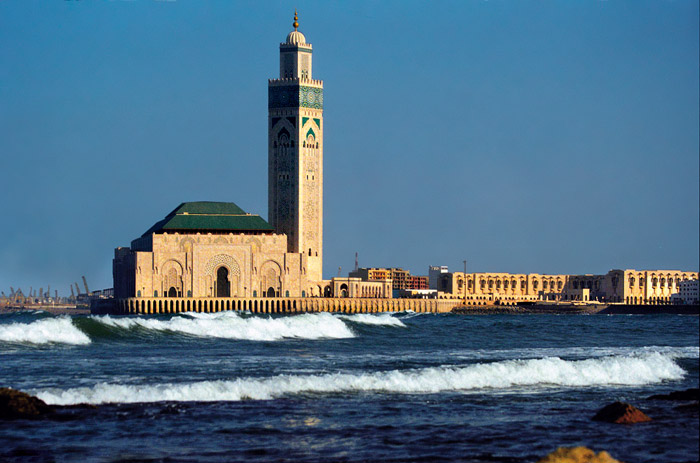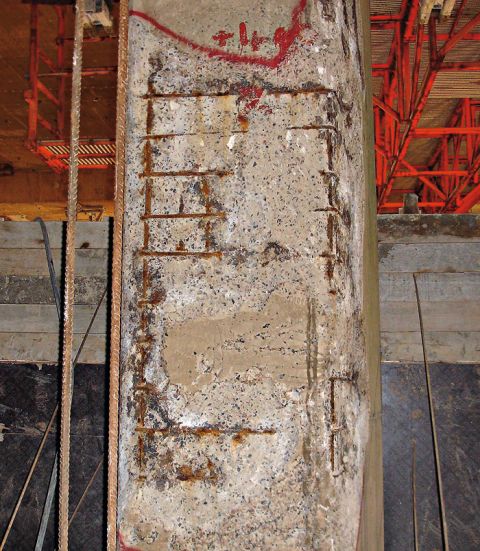The Hassan II Mosque began to show structural deterioration shortly after its inauguration: the concrete walls, which were built into the Atlantic Ocean, started to crumble under the steady attack of the saltwater waves. After a spectacular re-construction, replacing large parts of the original structure and reinforcing it with 1,300 metric tonnes of moly-grade duplex stainless steel, the mosque is ready to withstand the elements for decades to come.

The Hassan II Mosque in Casablanca, Morocco, is one of the largest in the world. Its unique location partially extending over the Atlantic Ocean requires special protection against the aggressive saltwater environment.
Photo: Jerzy Strzelecki.
An architectural jewel
The Hassan II Mosque in Casablanca, Morocco, is one of the largest mosques in the world. Exceptional in its vastness and luxury, it was designed by the French architect Michel Pinseau and inaugurated in 1993 after seven years and 50 million hours of construction work by 35,000 workers and craftsmen. It has been built on reclaimed land, so that almost half of the surface of the mosque lies over the Atlantic Ocean.
The mosque’s prayer room measures 200 x 100 m and can accommodate 25,000 worshippers. It has a movable, 60 m high, 3,400 m² large roof, which can be opened in five minutes through a rolling chain mechanism. Part of its floor is made of glass, so that worshippers can kneel directly over the sea. This feature was reportedly inspired by the Qur’an verse: “The throne of God was built on water.”The front square can host an additional 80,000 wor-shippers. The minaret, standing 210 m high, is the tallest in the world.
A highly aggressive environment
The mosque extends over the Atlantic Ocean and is partially in direct contact with seawater. As waves beat against the concrete walls, saltwater migrated into the porous concrete. When it reached the carbon steel rebar inside, the rebar started to rust. As rust forms on the rebar, it expands and presses against the concrete from inside the structure, leading eventually to cracking and loosening of the concrete and further penetration of the saltwater into the structure. Only ten years after its inauguration, this part of the mosque had deteriorated badly because of the corrosion of the rebar.
A reconstruction aimed to last 100 years
To remedy the problem, a major restoration project was launched in April 2005. Given the building’s importance, the authorities specified that the repaired structure should last 100 years. Three years of testing, study and review went into the design developed to meet the challenge. To meet the long-life requirement, the designers recommended the use of moly-grade stainless steel rebar combined with a concrete highly resistant to chloride penetration.
The rehabilitation work was performed in four phases over a four-year period:
- A watertight dike surrounding the mosque was first constructed to create a “dry” work site located 5 m below the highest water level.
- A portion of the voids under the prayer room was filled with concrete.
- Structural slabs and pillars surrounding the building on the ocean side were demolished.
- Identical replacements for these components were constructed using a high-performance concrete reinforced with 2205 duplex stainless steel (UNS S32205, EN 1.4462). This steel con-tains 3% molybdenum, which provides excellent resistance to corrosion in saltwater.
Chemical composition of 2205 duplex stainless steel (EN 1.4462/UNS S32205):
| |
C |
Si |
Mn |
Ni |
Cr |
Mo |
N |
| Min. |
|
|
|
4.5 |
21 |
2.5 |
0.11 |
| |
0.03 |
1 |
2 |
6.5 |
23 |
3.5 |
0.22 |
“Unlike traditional projects, the renovation of the ocean-exposed portions of the Hassan II Mosque, whose durability is vital, was planned with exceptional design and construction conditions, upon request from the Moroccan government,” explains Pierre Bessières, Construction Manager.



